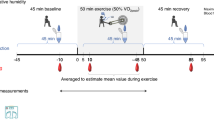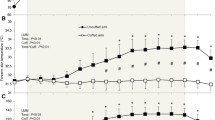Abstract
Purpose
Children thermoregulate effectively during exercise despite sweating rate being consistently lower when compared with adults. The skin blood flow (SkBF) response of children to exercise is inconsistent, when compared with adults. We examined the SkBF response to exercise in children and adults, along with the potential contribution of nitric oxide to the SkBF response.
Methods
Forearm SkBF during cycling (30 min at 60% \(\dot{V}\)O2max) was investigated in 12 boys (10 ± 1 years) and 12 men (22 ± 2 years) using laser-Doppler flowmetry and Nω-nitro-l-arginine methyl ester (L-NAME) iontophoresis to inhibit nitric oxide synthase.
Results
The exercise-induced SkBF increase was similar in boys and men (mean ± SD, 540 ± 127 vs. 536 ± 103% baseline, respectively, p = 0.43, d = 0.01 [− 0.8 to 0.8]). However, the total hyperaemic response to exercise (area-under-the-curve, AUC) indicated that boys had a greater vasodilatory response (cutaneous vascular resistance, CVC) (p < 0.01, d = 0.6 [− 1.2 to 2.8] than the men (134,215 ± 29,207 vs. 107,257 ± 20,320 CVC·s−1). L-NAME blunted the SkBF response more in boys than in men (group-by-treatment interaction, p < 0.001) and resulted in smaller AUC in boys (56,411 ± 23,033 CVC·s−1; p < 0.001, d = 1.4 [− 0.4 to 3.2] compared with men (80,556 ± 28,443 CVC·s−1; p = 0.08, d = 0.8 [0.0–1.6]). Boys had a shorter delay from the onset of exercise to onset of SkBF response compared with men (205 ± 48 and 309 ± 71 s, respectively; p < 0.01, d = 1.7 [0.9–2.8]). L-NAME increased the delay in boys and men (to 268 ± 90 and 376 ± 116 s, respectively; p = 0.01, d = 1.0 [0.4–2.1]) but this delay was not significantly different between the groups (p = 0.85).
Conclusions
These findings suggest that boys experience greater vasodilation and faster increases in SkBF during exercise compared with men. The contribution of nitric oxide to the SkBF response to exercise appears to be greater in boys than in men.




Similar content being viewed by others
Change history
13 March 2020
One of the co-authors, Raffy Dotan, wishes to remove his name from the original version of this article. The corrected author group should be.
Abbreviations
- ANOVA:
-
Analysis of variance
- BSA:
-
Body surface area
- BSA/M:
-
BSA-to-mass ratio
- % BF:
-
Body fat percentage
- CVC:
-
Cutaneous vascular conductance
- FBF:
-
Forearm blood flow
- LDF:
-
Laser Doppler flowmetry
- L-NAME:
-
Nω-Nitro-l-arginine methyl ester
- NO:
-
Nitric oxide
- NOS:
-
Nitric oxide synthase
- PU:
-
Perfusion units
- RPE:
-
Rating of perceived exertion
- SkBF:
-
Skin blood flow
- \(\overline{T}\) sk :
-
Mean skin temperature
- \(\user2{ }\dot{V}\)O2max :
-
Maximum oxygen consumptio
References
Araki T, Toda Y, Matsushita K, Tsujino A (1979) Age differences in sweating during muscular exercise. 体力科学 28:239–248. Doi:10.7600/jspfsm1949.28.239
Barker AR, Williams CA, Jones AM, Armstrong N (2011) Establishing maximal oxygen uptake in young people during a ramp cycle test to exhaustion. Br J Sports Med 45:498–503. https://doi.org/10.1136/bjsm.2009.063180
Bar-Or O (1980) Climate and the exercising child—a review. Int J Sports Med 01:53–65. https://doi.org/10.1055/s-2008-1034631
Berko J, Ingram DD, Saha S, Parker JD (2014) Deaths attributed to heat, cold, and other weather events in the United States, 2006–2010. Natl Health Stat Rep 2014:1–15
Borg GA (1973) Perceived exertion: a note on “history” and methods. Med Sci Sports 5:90–93
Cohen J (1988) Statistical power analysis for the behavioral sciences. Lawrence Erlbaum, Hillsdale
Davies CT (1981) Thermal responses to exercise in children. Ergonomics 24:55–61. https://doi.org/10.1080/00140138108924830
Dotan R, Ohana S, Bediz C, Falk B (2003) Blood lactate disappearance dynamics in boys and men following exercise of similar and dissimilar peak-lactate concentrations. J Pediatr Endocrinol Metab JPEM 16:419–429
Drinkwater BL, Kupprat IC, Denton JE et al (1977) Response of prepubertal girls and college women to work in the heat. J Appl Physiol 43:1046–1053. https://doi.org/10.1152/jappl.1977.43.6.1046
Du Bois D, Du Bois EF (1989) A formula to estimate the approximate surface area if height and weight be known. 1916. Nutr Burbank Los Angel Cty Calif 5:303–311 (discussion 312–313)
Falk B (1998) Effects of thermal stress during rest and exercise in the paediatric population. Sports Med Auckl NZ 25:221–240
Falk B, Dotan R (2008) Children’s thermoregulation during exercise in the heat: a revisit. Appl Physiol Nutr Metab Physiol Appl Nutr Metab 33:420–427. https://doi.org/10.1139/H07-185
Falk B, Dotan R (2017) Temperature regulation. Oxford textbook of children’s sport and exercise medicine, 3rd edn. Oxford University Press, Oxford, pp 195–222
Falk B, Bar-Or O, MacDougall JD et al (1991) Sweat lactate in exercising children and adolescents of varying physical maturity. J Appl Physiol Bethesda Md 71:1735–1740. https://doi.org/10.1152/jappl.1991.71.5.1735
Falk B, Bar-Or O, Calvert R, MacDougall JD (1992) Sweat gland response to exercise in the heat among pre-, mid-, and late-pubertal boys. Med Sci Sports Exerc 24:313–319
Hedvall Kallerman P, Hagman E, Edstedt Bonamy A-K et al (2014) Obese children without comorbidities have impaired microvascular endothelial function. Acta Paediatr Oslo Nor (1992) 103:411–417. https://doi.org/10.1111/apa.12549
Hodges GJ, Kosiba WA, Zhao K, Johnson JM (2008) The involvement of norepinephrine, neuropeptide Y, and nitric oxide in the cutaneous vasodilator response to local heating in humans. J Appl Physiol Bethesda Md (1985) 105:233–240. https://doi.org/10.1152/japplphysiol.90412.2008
Hodges GJ, Sharp L, Clements RE et al (2010) Influence of age, sex, and aerobic capacity on forearm and skin blood flow and vascular conductance. Eur J Appl Physiol 109:1009–1015. https://doi.org/10.1007/s00421-010-1441-7
Hodges GJ, Mallette MM, Tew GA et al (2017a) Effect of age on cutaneous vasomotor responses during local skin heating. Microvasc Res 112:47–52. https://doi.org/10.1016/j.mvr.2017.03.002
Hodges GJ, Stewart DG, Davison PJ, Cheung SS (2017b) The role of shear stress on cutaneous microvascular endothelial function in humans. Eur J Appl Physiol 117:2457–2468. https://doi.org/10.1007/s00421-017-3732-8
Hodges GJ, Mueller MC, Cheung SS, Falk B (2018) Cutaneous vasomotor responses in boys and men. Appl Physiol Nutr Metab Physiol Appl Nutr Metab. https://doi.org/10.1139/apnm-2018-0083
Iellamo F, Legramante JM, Raimondi G et al (1996) Evaluation of reproducibility of spontaneous baroreflex sensitivity at rest and during laboratory tests. J Hypertens 14:1099–1104
Inoue Y, Kuwahara T, Araki T (2004) Maturation- and aging-related changes in heat loss effector function. J Physiol Anthropol Appl Human Sci 23:289–294
Johnson JM, Taylor WF, Shepherd AP, Park MK (1984) Laser-Doppler measurement of skin blood flow: comparison with plethysmography. J Appl Physiol 56:798–803. https://doi.org/10.1152/jappl.1984.56.3.798
Kellogg DL, Crandall CG, Liu Y et al (1998) Nitric oxide and cutaneous active vasodilation during heat stress in humans. J Appl Physiol Bethesda Md (1985) 85:824–829. https://doi.org/10.1152/jappl.1998.85.3.824
Kellogg DL, Johnson JM, Kosiba WA (1989) Selective abolition of adrenergic vasoconstrictor responses in skin by local iontophoresis of bretylium. Am J Physiol 257:H1599–1606. https://doi.org/10.1152/ajpheart.1989.257.5.H1599
Martin HL, Loomis JL, Kenney WL (1995) Maximal skin vascular conductance in subjects aged 5–85 yr. J Appl Physiol Bethesda Md (1985) 79:297–301. https://doi.org/10.1152/jappl.1995.79.1.297
McGarr GW, Hodges GJ, Cheung SS (2017) Between-day reliability of local thermal hyperemia in the forearm and index finger using single-point laser Doppler flowmetry. Microcirc N Y N 1994. https://doi.org/10.1111/micc.12395
McNamara TC, Keen JT, Simmons GH et al (2014) Endothelial nitric oxide synthase mediates the nitric oxide component of reflex cutaneous vasodilatation during dynamic exercise in humans. J Physiol 592:5317–5326. https://doi.org/10.1113/jphysiol.2014.272898
Minson CT, Holowatz LA, Wong BJ et al (2002) Decreased nitric oxide- and axon reflex-mediated cutaneous vasodilation with age during local heating. J Appl Physiol Bethesda Md (1985) 93:1644–1649. https://doi.org/10.1152/japplphysiol.00229.2002
Mirwald RL, Baxter-Jones ADG, Bailey DA, Beunen GP (2002) An assessment of maturity from anthropometric measurements. Med Sci Sports Exerc 34:689–694
Ramanathan NL (1964) A new weighting system for mean surface temperature of the human body. J Appl Physiol 19:531–533. https://doi.org/10.1152/jappl.1964.19.3.531
Rees J, Shuster S (1981) Pubertal induction of sweat gland activity. Clin Sci Lond Engl 1979 60:689–692
Rivera-Brown AM, Rowland TW, Ramírez-Marrero FA et al (2006) Exercise tolerance in a hot and humid climate in heat-acclimatized girls and women. Int J Sports Med 27:943–950. https://doi.org/10.1055/s-2006-923863
Rowland T (2008) Thermoregulation during exercise in the heat in children: old concepts revisited. J Appl Physiol Bethesda Md (1985) 105:718–724. https://doi.org/10.1152/japplphysiol.01196.2007
Rowland T, Hagenbuch S, Pober D, Garrison A (2008) Exercise tolerance and thermoregulatory responses during cycling in boys and men. Med Sci Sports Exerc 40:282–287. https://doi.org/10.1249/mss.0b013e31815a95a7
Sansum KM, Weston ME, Bond B et al (2019) Validity of the supramaximal test to verify maximal oxygen uptake in children and adolescents. Pediatr Exerc Sci 31:213–222. https://doi.org/10.1123/pes.2018-0129
Sawilowsky SS (2009) New effect size rules of thumb. J Mod Appl Stat Methods 8:467–474
Shastry S, Dietz NM, Halliwill JR et al (1998) Effects of nitric oxide synthase inhibition on cutaneous vasodilation during body heating in humans. J Appl Physiol Bethesda Md (1985) 85:830–834. https://doi.org/10.1152/jappl.1998.85.3.830
Shibasaki M, Inoue Y, Kondo N, Iwata A (1997) Thermoregulatory responses of prepubertal boys and young men during moderate exercise. Eur J Appl Physiol 75:212–218. https://doi.org/10.1007/s004210050150
Shibasaki M, Inoue Y, Kondo N et al (1999) Relationship between skin blood flow and sweating rate in prepubertal boys and young men. Acta Physiol Scand 167:105–110. https://doi.org/10.1046/j.1365-201x.1999.00597.x
Slaughter MH, Lohman TG, Boileau RA et al (1988) Skinfold equations for estimation of body fatness in children and youth. Hum Biol 60:709–723
Tanner JM (1962) Growth at adolescence: with a general consideration of the effects of hereditary and environmental factors upon growth and maturation from birth to maturity, 2nd edn. Blackwell Scientific Publications, Oxford
Tew GA, George KP, Cable NT, Hodges GJ (2012a) Endurance exercise training enhances cutaneous microvascular reactivity in post-menopausal women. Microvasc Res 83:223–228. https://doi.org/10.1016/j.mvr.2011.09.002
Tew GA, Saxton JM, Hodges GJ (2012b) Exercise training and the control of skin blood flow in older adults. J Nutr Health Aging 16:237–241
Tyle P (1986) Lontophoretic devices for drug delivery. Pharm Res 3:318–326. https://doi.org/10.1023/A:1016327822325
Welch G, Foote KM, Hansen C, Mack GW (2009) Nonselective NOS inhibition blunts the sweat response to exercise in a warm environment. J Appl Physiol Bethesda Md (1985) 106:796–803. https://doi.org/10.1152/japplphysiol.90809.2008
Acknowledgements
We thank the participants and the parents of the child participants for volunteering their time and effort in this study.
Funding
This study was supported by a Collaborative Health Research Project Grant co-sponsored by Canadian Institutes for Health Research and the Natural Science and Engineering Research Council.
Author information
Authors and Affiliations
Contributions
GH, PK and BF conceived and designed research. AW, GH, and RJM conducted experiments. AW, GH and BF analyzed data and wrote the manuscript. PK commented on previous versions. All authors read and approved the manuscript.
Corresponding author
Ethics declarations
Conflict of interest
The authors declare that they have no competing interest.
Additional information
Communicated by George Havenith.
Publisher's Note
Springer Nature remains neutral with regard to jurisdictional claims in published maps and institutional affiliations.
The original version of this article was revised: One of the co-authors Raffy Dotan wishes to remove his name.
Rights and permissions
About this article
Cite this article
Woloschuk, A., Hodges, G.J., Massarotto, R.J. et al. The skin blood flow response to exercise in boys and men and the role of nitric oxide. Eur J Appl Physiol 120, 753–762 (2020). https://doi.org/10.1007/s00421-019-04286-4
Received:
Accepted:
Published:
Issue Date:
DOI: https://doi.org/10.1007/s00421-019-04286-4




